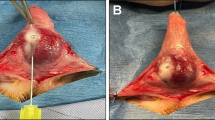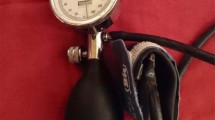Abstract
The objective of this study was to evaluate the possible role of transforming growth factor beta 1 (TGF-β1) antibodies (ab) for the prevention of fibrotic effects of priapism in a rat model. In total, 30 adult Sprague–Dawley rats were divided into five groups. Priapism with 6 h (group 1), priapism with 6 h+ab (group 2), priapism with 24 h (group 3), priapism with 24 h+ab (group 4) and control (group 5). Priapism was induced with a vacuum erection device and a rubber band was placed at the base of the erect penis. At 1 h after the initiation of priapism, TGF-β1 antibodies were given intracavernosaly. All rats underwent electrical stimulation of the cavernous nerve after 8 weeks. Intracavernous and systemic blood pressures were measured during the procedure. Rats in group 1 showed significantly higher (intracavernosal pressure (ICP) pressures to cavernous nerve stimulation and had higher ICP/BP ratios when compared to other groups. Similarly, histopathologic examination revealed less fibrosis in group 2, compared with the other groups. Consequently, TGF-β1 antibodies antagonise the fibrotic effects of TGF-β1, especially in cases with duration of priapism less than 6 h.
This is a preview of subscription content, access via your institution
Access options
Subscribe to this journal
Receive 8 print issues and online access
$259.00 per year
only $32.38 per issue
Buy this article
- Purchase on Springer Link
- Instant access to full article PDF
Prices may be subject to local taxes which are calculated during checkout



Similar content being viewed by others
References
The AFUD Thought Leader Panel on Evaluation and Treatment of Priapism. Report of the AFUD Thought Leader Panel for evaluation and treatment of priapism. Int J Impot Res 2001; (Suppl 5): S39–S43.
Pautler SE, Brock GB . Priapism. Urol Clin North Am 2001; 28: 391–403.
Moreland RB . Is there a role of hypoxemia in penile fibrosis: a viewpoint presented to the Society for the Study of Impotence. Int J Impot Res 1998; 10: 113–120.
Nehra A et al. Transforming growth factor-β1 (TGF-β1) is sufficient to induce fibrosis of rabbit corpus cavernosum in vivo. J Urol 1999; 162: 910–915.
Nehra A et al. Mechanisms of venous leakage: a prospective clinicopathological correlation of corporeal function and structure. J Urol 1996; 156: 1320–1329.
Moreland RB et al. PE1 suppresses the induction of collagen synthesis by transforming growth factor-β1 in human corpus cavernosum smooth muscle. J Urol 1995; 153: 826–834.
Ul-Hassan M et al. Expression of TGF-beta 1 mRNA and ultrastructural alterations in pharmacologically induced prolonged penile erection in a canine model. J Urol 1998; 160: 2263–2266.
Shah M, Foreman DM, Ferguson MW . Control of scarring in adult wounds by neutralizing antibody to transforming growth factor beta. Lancet 1992; 25: 213–214.
Schultze-Mosgau S et al. Anti-TGFbeta1 antibody for modulation of expression of endogenous transforming growth factor beta 1 to prevent fibrosis after plastic surgery in rats. Br J Oral Maxillofac Surg 2004; 42: 112–119.
Lucas PA, Warejcka DJ, Young HE, Lee BY . Formation of abdominal adhesions is inhibited by antibodies to transforming growth factor-beta1. J Surg Res 1996; 65: 135–138.
Nath RK et al. Antibody to transforming growth factor beta reduces collagen production in injured peripheral nerve. Plast Reconstr Surg 1998; 102: 1100–1106.
Dillard DG et al. Transforming growth factor and neutralizing antibodies in subglottic stenosis. Ann Otol Rhinol Laryngol 2001; 110 (5 Part 1): 393–400.
Chen KK et al. Intracavernous pressure as an experimental index in a rat model for the evaluation of penile erection. J Urol 1992; 147: 1124–1128.
Martinez-Pineiro L et al. Rat model for the study of penile erection: pharmacologic and electrical stimulation parameters. Eur Urol 1994; 25: 62–70.
Rehman J et al. Diminished neurogenic but not pharmacological erections in the 2- to 3-month experimentally diabetic F-344 rat. Am J Physiol 1997; 272: 1960–1971.
Jones ML . Connective tissue and stains. In: Bancroft J, Gamble M (ed). Theory and Practice of Histological Techniques 5th edn. Churchill Livingstone Company: China, 2002 p 153.
Montague DK et al. Erectile Dysfunction Guideline Update Panel of the American Urological Association Education and Research, Inc. Guideline on the management of priapism, 2003. Website: http://www.auanet.org/timssnet/products/guidelines/main_reports.
Burnett AL . Pathophysiology of priapism: dysregulatory erection physiology thesis. J Urol 2003; 170: 26–34.
Saenz De Tejada I et al. Acidosis impairs rabbit trabecular smooth muscle contractility. J Urol 1997; 157: 722–726.
Broderick GA, Gordon D, Hypolite J, Levine RM . Anoxia and corporal smooth muscle dysfunction: a model for ischemic priapism. J Urol 1994; 151: 259–262.
Kim NN et al. Altered contractility of rabbit penile corpus cavernosum smooth muscle by hypoxia. J Urol 1996; 155: 772–778.
Evliyao∂lu Y, Kayrin L, Kaya B . Effect of allopurinol on lipid peroxidation induced in corporeal tissue by veno-occlusive priapism in a rat model. BJU 1997; 80: 476–479.
Munarriz R et al. Reperfusion of ischemic corporal tissue: physiologic and biochemical changes in an animal model of ischemic priapism. Urology 2003; 62: 760–764.
Monga M, Broderick GA, Hellstrom WJG . Priapism in sickle cell disease: the case for early implantation of the penile prosthesis. Eur Urol 1996; 30: 54–59.
Leof EB, Proper JA, Gets MJ, Moses HL . Transforming growth factor beta regulation of actin mRNA. J Cell Physiol 1986; 127: 83–88.
Ignotz RA, Massagué J . Transforming growth factor beta stimulates the expression of fibronectin and collagen and their incorporation into the extracellular matrix. J Biol Chem 1986; 261: 4337–4345.
Penntinen RP, Kobayashi S, Bornstein P . Transforming growth factor beta increase mRNA for matrix proteins in the presence and absence of mRNA stability. Proc Natl Acad Sci USA 1988; 85: 1105–1108.
Leungwattanakij S et al. Cavernous neurotomy causes hypoxia and fibrosis in rat corpus cavernosum. J Androl 2003; 24: 239–245.
Tefekli A et al. The effect of decorin on the rat model of Peyronie's disease. AUA 96. Meeting, June 2–7 Anaheim, California, 2001 (abst. no: 828).
Spycher MA, Hauri D . The ultrastructure of the erectile tissue in priapism. J Urol 1986; 135: 143–147.
Author information
Authors and Affiliations
Corresponding author
Additional information
Source of funding: Istanbul University Research Foundation.
Rights and permissions
About this article
Cite this article
Sanli, O., Armagan, A., Kandirali, E. et al. TGF-β1 neutralizing antibodies decrease the fibrotic effects of ischemic priapism. Int J Impot Res 16, 492–497 (2004). https://doi.org/10.1038/sj.ijir.3901261
Received:
Revised:
Accepted:
Published:
Issue Date:
DOI: https://doi.org/10.1038/sj.ijir.3901261
Keywords
This article is cited by
-
The effect of an antifibrotic agent, pirfenidone, on penile erectile function in an experimental rat model of ischemic priapism
International Journal of Impotence Research (2020)
-
The effects of oxytocin on penile tissues in experimental priapism model in rats
International Urology and Nephrology (2019)
-
The effect of pentoxifylline on penile cavernosal tissues in ischemic priapism-induced rat model
International Urology and Nephrology (2014)
-
An animal model of ischemic priapism and the effects of melatonin on antioxidant enzymes and oxidative injury parameters in rat penis
International Urology and Nephrology (2010)
-
Molecular science of priapism
Current Sexual Health Reports (2007)



